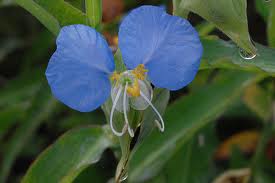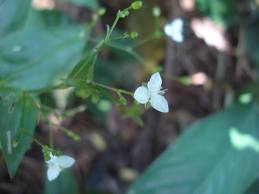Commelina diffusa: What a day for a dayflower
Common names can be a headache when one is trying to index a plant. The plant to the lower right is commonly known as the Asiatic Dayflower but it is not. It is also called just the Dayflower. More so there are native North American Dayflowers in a different genus. It can get rather confusing. On top of that many Commelinas are reported edible raw but I am beginning to think they should be cooked. They have a high oxalate content, less in young plants, more in older. Pick carefully.
Introduced from Asia to Florida, the little plant to the right is Commelina diffusa (kom-uh-LIN-uh dye-FEW-sah.) The Florida native is Commelina erecta. Another import is C. communis. How do you tell them apart? With the crawling difussa the three flower petals are almost almost the same size and blue. With the erecta and communis two blue petals are much larger than the white one. The erecta tends to stand up on its own, the communis crawls.
The Commelina species are often found in the same place as the spiderwort and young shoots and tips are good steamed, as a pot herb or boiled for a 20 minutes or so or fried. The blossoms are a trail side nibble for me or an addition to salads. Two have starchy roots that are edible cooked but are slimy, Commelina coelestis and Commelina benghalensis, the latter also has edible young tips when cooked and blossoms. In fact, other than blossoms I think any Commelina said to be edible raw is probably better off cooked and then only shoots or young tips. That’s what my tummy tells me. Oh, seeds of the Communis have been used as famine food.
Yellow Commelina Update: While conduction a class in Tampa in 2011 one of my students who has come to many classes, Maryann Pugliesi, spotted a Commelina with yellow blossoms, something I had never seen before. A bit of research showed it to be Commelina africana, or Yellow Commelina, and imported ground cover. Very common in South Africa it’s leaves are edible cooked and root. I suspect the blossoms are edible raw. On my next trip to Tampa I will find out.
Diffusa means spreading. Erecta means up right. Communis, wide-spread. The name Commelina was used in honor of three Dutch brothers of the Commelijn family, botanists all. One, however, died young and the Commelina communis was specifically named for them. Incidentally, the Commelinas are diuretic and have many herbal applications as well. Some yield a dye. Africana means from Africa. To read about spiderworts click here.
Green Deane’s “Itemized” Plant Profile
IDENTIFICATION: Erecta: grows up, two prominent sky-blue petals that stick out like mouse ears, third petal is tiny, white, below the blossom. Difussa, three blue petals close to the same size. Blossoms at the end of stems surrounded by heart-shaped leaf, rest of leaves three-inches long, narrow and pointed, with parallel veins along their length
TIME OF YEAR: Leaves and flowers year round in Florida, leaves all but winter up north, flowers spring and early summer
ENVIRONMENT: Grows in average, medium moisture, well-drained moist acidic soil, full sun to full shade. Tolerates poor soils. Lawns, roadsides, moist waste areas.
METHOD OF PREPARATION: I recommend you cook (boil or fry) the young greens of all the edible Commelina save for blossoms, shoots and young tips which can be tried raw in small amounts. Roots of the coelestris and benghalensis must be cooked.
Don’t confuse the Commelinas with a similar-looking escaped ornamental, Gibasis geniculata. It has all-white blossoms on very long stems and its leaves are purple on the back. Though called the Tahitian Bridal Veil it is from Tropical America.



